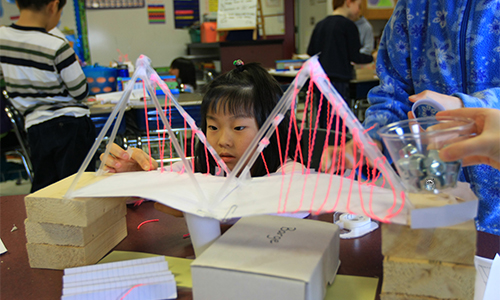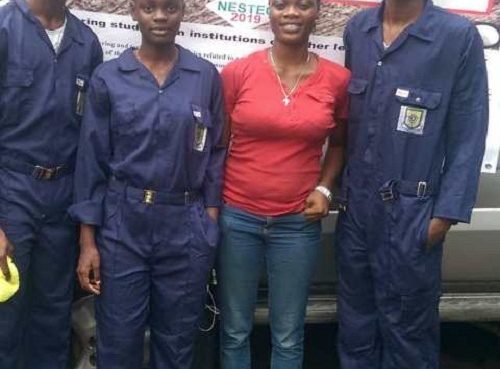Engineering instruction should build on young students’ natural problem-solving skills to prepare a future generation of critical thinkers.
When Christine Cunningham, an education researcher and vice president at the Museum of Science in Boston, prompts elementary school students to draw an engineer at work, the pictures they hand in never surprise her. In fact, for the thousands of students Cunningham has polled around the country in recent years, childhood perceptions of engineers have been strikingly consistent — and consistently inaccurate.
“Children think engineers drive trains,” she says. Some sketch construction workers assembling buildings, bridges or roads. “The kids think engineers build these structures, not design them,” Cunningham explains. While not altogether unexpected, Cunningham says such childhood misconceptions are troubling. “If you have no idea what engineers do, then it’s not very likely that you’ll think about this as a career path,” she says.
Kids learn about the natural world in science classes, but what about the human-made world built on top of it — the buildings and vehicles and screens where they spend the vast majority of their time? This world, constructed by engineers, rarely appears in the curriculum until college, and even then, as little as 8 percent of incoming freshmen choose to pursue an engineering major, says Leigh Abts, a research associate at the University of Maryland’s School of Engineering and College of Education. Only half of those students will actually earn a degree in the field.
Repairing the Pipeline
The deficit is clear. Our society depends upon engineers to design every aspect of our lives — where we live, what we drive, how we communicate and even what we eat — but America’s primary and secondary education systems aren’t producing enough critical thinkers to keep up with the demand. This is according to a national initiative aimed at identifying and fixing the U.S. education system’s “leaky engineering talent pipeline,” led by the National Academy of Sciences, Achieve, the American Association for the Advancement of Science and the National Science Teachers Association.
The group recently released Next Generation Science Standards based on research from the National Science Foundation (NSF). The standards raise the bar for integrating science, technology, engineering and mathematics content — collectively, STEM — into elementary and high school classrooms.
“We are focusing on the E in STEM,” says Joan Ferrini-Mundy, assistant director of the NSF’s Directorate for Education and Human Resources. Engineering provides an overlooked opportunity to teach kids how to work together and solve problems at a very young age, Ferrini-Mundy says. Such experiences can empower them to do so later in life, when the stakes are higher.
Instead of a concrete curriculum or a test that students must be able to pass, the science and engineering standards lay out benchmarks for what concepts students should know at particular grade levels, each year building on those before it. They up the ante from previous iterations of science standards by integrating engineering ideas into math and language arts classes and applying engineering skills to real-world scenarios so students are better prepared for such experiences outside of school. This means instead of teaching facts that kids can just as easily Google, for example, science education should “enable students to evaluate and select reliable sources of scientific information,” according to the standards.
The new suite of standards is necessarily open-ended, recognizing that teachers need the flexibility to teach different students in different ways. As such, the standards don’t offer specifics on how teachers should bring engineering into the classroom. “Many K-to-12 teachers are not aware of how engineering can be used to inspire and improve student performance,” says Mo Hosni, vice president of the American Society of Mechanical Engineers’ board on education. That’s where programs like Cunningham’s come in.
Engineering Is Elementary
“Younger students need experiences with engineering and technology if they’re going to succeed in our 21st-century world — a world that increasingly depends on these disciplines,” says Cunningham, who is also the founding director of Engineering is Elementary, a program that brings engineering concepts into elementary school classrooms around the country.
In her work with Engineering is Elementary at the Museum of Science in Boston, Cunningham sees countless kids at play. She watches 3-year-olds building bridges and knocking down towers. She observes them take things apart to understand how they work. “The more I watch young children interact with the world around them, the more I am convinced that they are natural engineers,” she says.
But schools are failing to nurture these natural design inclinations, Cunningham says. Worse, rigid math- and language-arts-centric curricula can actually educate these engineering tendencies right out of children. The ubiquitous worksheet model asks kids to memorize and regurgitate facts instead of creatively applying those facts to solve problems.
Problem-solving skills should be considered a basic literacy, says Cunningham. “Everybody, regardless of whether or not they go on to college or go on to become engineers, needs to know something about how the human-made world that they live in comes to be,” she says. STEM fields are increasingly important to our fast-paced and fast-changing society, but remain underrepresented in schools, Cunningham says.
Engineering is Elementary provides curricula that teachers can use to work toward the goals set by the Next Generation Science Standards. She and her colleagues have composed interactive lessons that empower kindergarten through fifth-grade teachers to introduce topics that may go beyond their areas of expertise or familiarity.
Few teachers are mechanical engineers, for example, but one unit introduces students to the power and behavior of moving air, then has them design mechanical windmills to turn that movement into usable energy. In this way, the lessons show children how to palpably grasp real-world problems and demonstrate how engineers use math and science to frame, analyze and eventually solve those problems.
So far, Cunningham’s program has reached 4 million children by introducing engineering concepts through familiar avenues like storybooks. To tackle environmental engineering, for example, students read about a Native American girl named Tehya who is snapping pictures of landscapes near her tribal home in Washington state when she discovers oil on the surface of the Elwha River.
As Tehya explores the extent of the damage to the interconnected elements of the ecosystem on which her community depends, students see the far-reaching social and environmental impacts of even small-scale water pollution.
In an accompanying lesson, students conduct pH tests on supplied soil and water samples to trace the source of pollutants from a factory in a fictional location called Greentown. They also use various materials and methods to see what will best clean up an oil spill simulated in a 9-by-9-inch pan. Spoons, they find through trial and error, are far less effective cleaning agents than soap and sponges.
Such simple exercises hold great value, says Cunningham: The students learn how to navigate a challenge by
trying, failing and rethinking their designs and then trying some more. “The idea that failure is good can be a radical concept in the schoolroom, and it can be a new experience for students, but it’s how engineering works,” Cunningham says. Each failure informs a future design that brings an engineer one step closer to success.











16 thoughts on “Teaching Kids to Think Like Engineers”